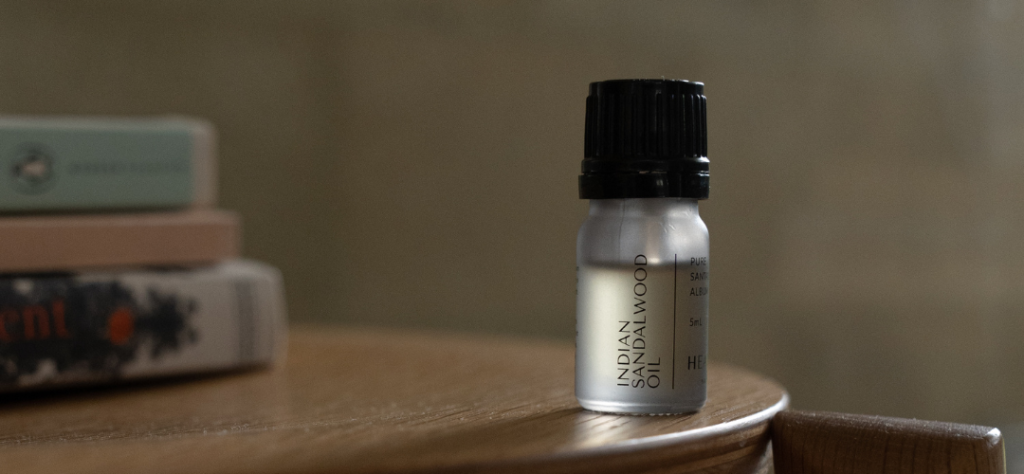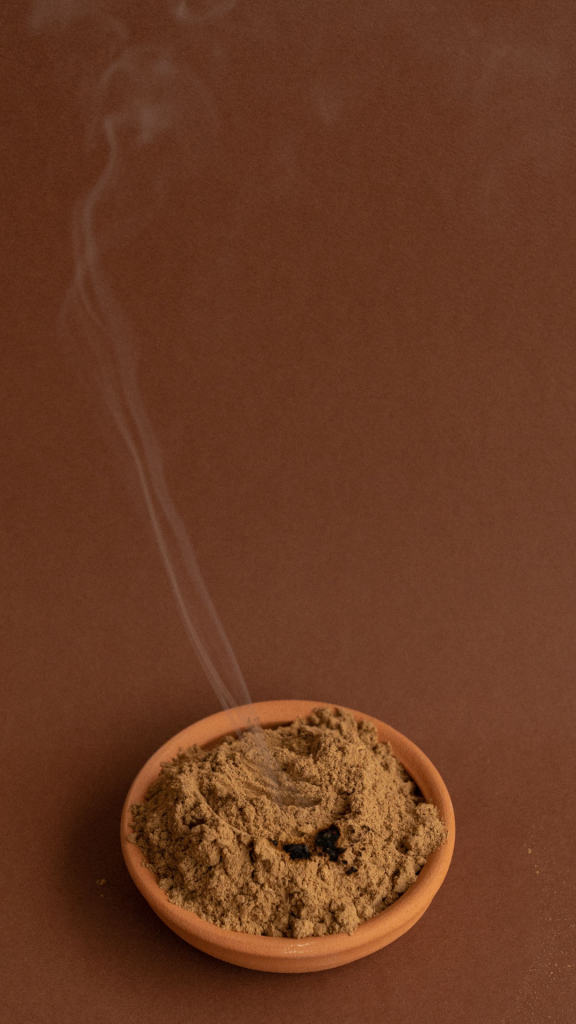TIMELESS WELLNESS
WHAT IS AROMATHERAPY?
Some essential oils distilled from plants possess natural chemical compositions that can influence one’s mood and mental state. Depending on the plant and its properties, these oils can induce therapeutic benefits, invigorating, calming, focusing, or aiding sleep – hence the name, aromatherapy.
WHAT PART DOES INDIAN SANDALWOOD PLAY IN AROMATHERAPY?
The woody, warm scent of Indian sandalwood is known for its ability to calm and ground the mind and body. Its use as a therapeutic ingredient to calm the nervous system has been embraced across times and cultures.

One of its earliest historical uses as a wellness ingredient dates back to Traditional Chinese Medicine, where it was and is still used to treat anxiety and nervous tension [1].
Buddhism too has a history entwined with Indian sandalwood, where it is used to focus and calm the mind during meditation, and in prayer beads to ground the wearer.
‘Sandalwood oil has a relaxing effect on the nerves and may be used for hot, agitated emotional states that lead to conditions such as headache, insomnia and nervous tension.’
Battaglia, S (2005) The Complete Guide to Aromatherapy, Brisbane: The International Centre of Holistic Aromatherapy. P 264 [2].
In this article, we chat to Kat Snowden, one of Australia’s most celebrated aromatherapists, to discover the benefits of using Indian sandalwood in aromatherapy.

Q: WHY DO YOU USE INDIAN SANDALWOOD AS AN ESSENTIAL OIL?
A: Indian sandalwood has so much therapeutic value, including anti-inflammatory, anti-microbial and sedative properties. Indian sandalwood oil is useful in treating the lymphatic system, the nervous system, the respiratory system, and skin conditions.
Q: HOW DO ESSENTIAL OILS WORK?
A: Essential oils are the principal therapeutic tools of aromatherapy. When inhaled the scent molecules of the essential oils travel from the olfactory nerve to the emotional centre of the brain, triggering an emotional response.
Indian sandalwood has a uniquely high concentration of sesquiterpenes – alpha and beta santalols – which enter the bloodstream and the receptors in the brain responsible for attentiveness and alertness, put their calming and focusing properties to work.
Q: DO ESSENTIAL OILS HAVE TO BE INHALED TO DELIVER THE CALMING BENEFITS?
A: In addition to inhalation, essential oils can be very beneficial when absorbed through the skin. When used on the skin, sandalwood can help with conditions such as eczema, psoriasis, and dermatitis.
Q: WHAT ARE THE BEST/MOST POPULAR OILS TO BLEND WITH INDIAN SANDALWOOD?
A: So many essential oils blend well with Indian sandalwood. Some of my favorites are Frankincense, Vetiver, Jasmine, Bergamot, Ylang Ylang, Neroli and Black Pepper.
Q: IS IT JUST THE SANDALWOOD OIL THAT CAN BE USED FOR AROMATHERAPY?
A: Sandalwood powder and hydrosols are great to use in aromatherapy. Sandalwood powder makes a stunning incense, and hydrosols can be used for their therapeutic value in skin care.

Q: WHAT SHOULD YOU LOOK FOR / BE AWARE OF WHEN DECIDING WHERE TO PURCHASE ESSENTIAL OILS FROM?
Unfortunately, there are many adulterated essential oils out there and it is not well regulated in Australia. When I am purchasing oils, I look for brands that list the botanical name on the bottle, are transparent and openly talk about their supply chain. Smelling the oils will tell you so much about the quality of them.
Our plantations are some of the only sustainable sources of Indian sandalwood in the world.
Severe overharvesting and high demand has seen Indian sandalwood appearing on the ICUN list of endangered species since 1998.
Consequently, the market has seen an influx of adulterated, illegitimate, and black market Indian sandalwood product, making authentic and sustainably sourced Indian sandalwood all the more important.
Q: IS THERE A REASON THAT INDIAN SANDALWOOD BLENDS WITH SO MANY SCENT PROFILES?
The soft, sweet, and woody profile of Indian sandalwood makes it such a beautiful oil to blend with others. Its long-lasting aroma enhances other scents imparting a balance, warmth, and harmony to blends.
Indian sandalwood’s ability to enhance other scents dates back to ancient Indian attars. Its ability to bind to other fragrance molecules combined with its long-lingering properties, saw it used as a base note to compliment and intensify (but not overpower) the scent of the other herbs and flowers used in the attars [3].

To this day, Indian sandalwood continues to be a highly coveted base note in fragrances across the world, from essential oils, to perfumes, to candles and incense.
REFERENCES
- Misra, Biswapriya B. & Satyahari Dey 2013, ‘Biological Activities of East Indian Sandalwood Tree Santalum album’, Natural Product Communications Vol. 0 No. 1-2.
- Battaglia, S (2005) The Complete Guide to Aromatherapy, Brisbane: The International Centre of Holistic Aromatherapy. P 264
- C, Sandeep & TN, Manohara. (2019). Sandalwood in India: Historical and cultural significance of Santalum album L. as a basis for its conservation. NeBIO. 10. 235-242.
